Name Atlantic Conveyor Completed 1970 Tonnage 13.56 million kg | Length 212 m Beam 28 m | |
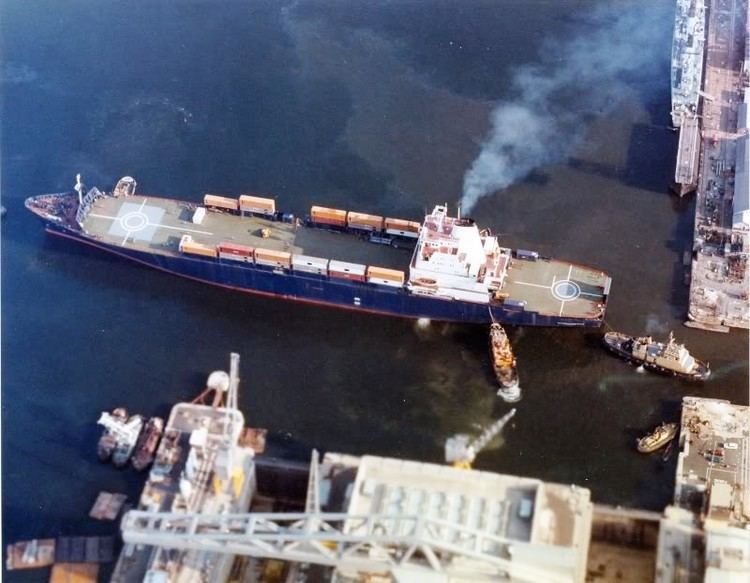 | ||
Fate struck by two Exocet missiles on 25 May 1982Burnt and subsequently abandonedEventually sank whilst under tow on 28 May 1982 | ||
Atlantic Conveyor was a British merchant navy ship, registered in Liverpool, that was requisitioned during the Falklands War.
Contents
She was hit on 25 May 1982 by two Argentine air-launched AM39 Exocet missiles, killing 12 sailors. Atlantic Conveyor sank whilst under tow on 28 May 1982.
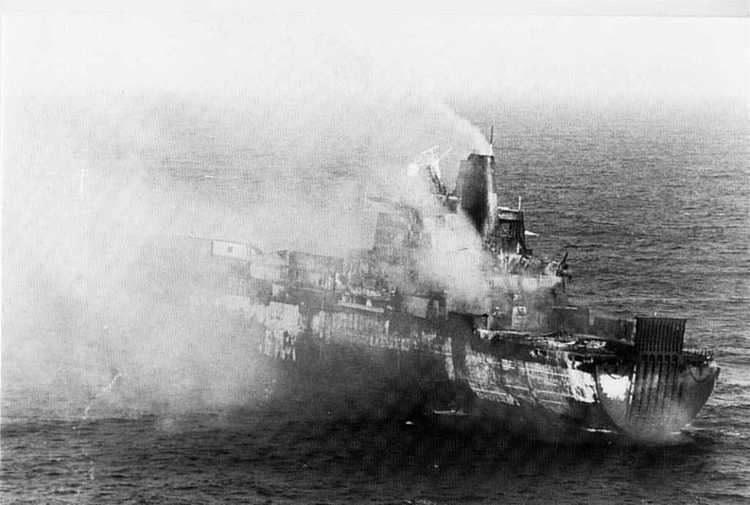
The wrecksite is designated under the Protection of Military Remains Act 1986.
History

Atlantic Conveyor was a 14,950 ton roll-on, roll-off container ship owned by Cunard. She was built along with six other container ships, each named Atlantic .... and sailing under different national flags for different companies.
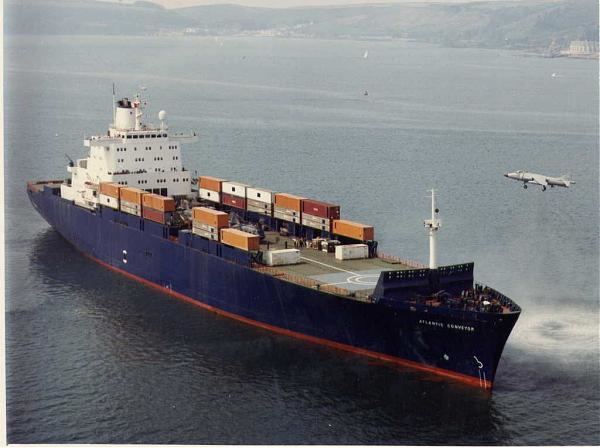
Along with her sister ship, Atlantic Causeway, Atlantic Conveyor was requisitioned by the Ministry of Defence at the beginning of the Falklands War through the STUFT system (Ships Taken Up From Trade). Due to the short timescales, the decision that the ship was not "a high-value unit" and a controversy over whether arming auxiliaries was legal, Atlantic Conveyor was not fitted with either an active or a passive defence system.
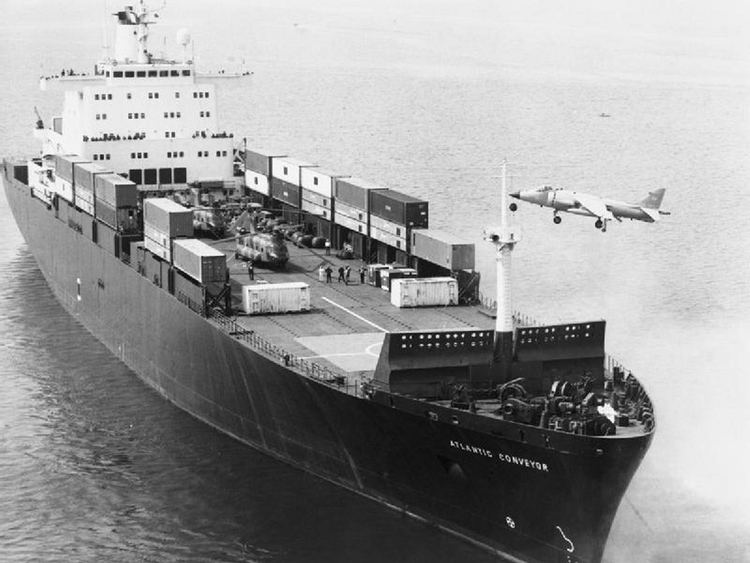
The ships were used to carry supplies for the Royal Navy Task Force sent by the British government to retake the Falkland Islands from Argentine occupation. Sailing for Ascension Island on 25 April 1982, Atlantic Conveyor carried a cargo of six Wessex helicopters from 848 Naval Air Squadron and five RAF Chinook HC.1s from No. 18 Squadron RAF. At Ascension, she picked up eight Fleet Air Arm Sea Harriers (809 Squadron) and six RAF Harrier GR.3 jump jets.
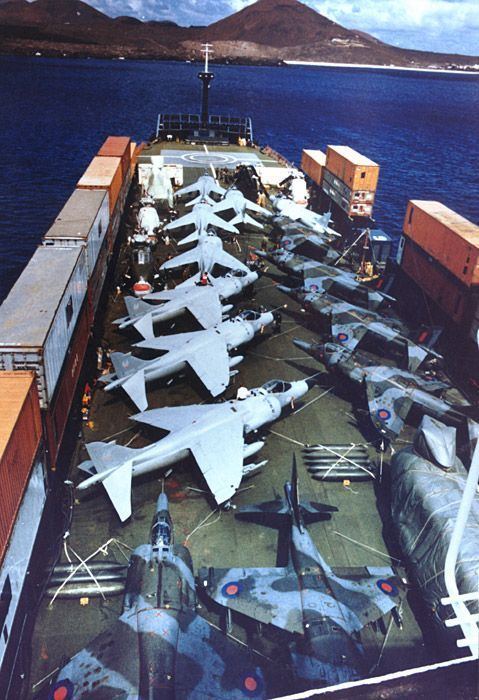
One Chinook of B flight No. 18 Squadron RAF left Atlantic Conveyor to support operations on Ascension. With the aircraft stored she then set sail for the South Atlantic. On arrival off the Falklands in mid-May, all of the Harriers were off-loaded to the carriers; the GR.3s going to HMS Hermes while the Sea Harriers were divided amongst the existing squadrons on Hermes and HMS Invincible. With the additional aircraft on Hermes a Lynx HAS.2 helicopter was flown and parked on the Atlantic Conveyor on 20 May 1982.

On 25 May 1982 (the same day as the loss of HMS Coventry) Atlantic Conveyor was hit by two AM39 Air Launched Exocet missiles fired by two Argentine Navy Super Étendard jet fighters. The mission was led by Corvette Captain Roberto Curilovic (call sign 'Tito'), flying Super Etendard 0753/3-A-203, and his wingman, Warship Lieutenant Julio Barraza, (call sign 'Leo') flying in 0754/3-A-204 — both from 2da Escuadrilla Aeronaval de Caza y Ataque.
Both Exocets struck Atlantic Conveyor on the port quarter of the ship. There are conflicting accounts on whether the warheads exploded after penetrating the ship's hull, or on impact. Due to the presence of both fuel and ammunition that were stored below decks, the incendiary effect of the unburnt propellant from the missiles caused an uncontrollable fire. When the fire had burnt out, the ship was boarded but nothing was recovered. While under tow by the requisitioned tug Irishman, Atlantic Conveyor sank in the early morning of 28 May 1982. All the helicopters but one Chinook, squadron identification code Bravo November, were destroyed in the fire. The loss of these helicopters meant that British troops had to march on foot across the Falklands to recapture Stanley.
Twelve men died in Atlantic Conveyor, including the ship's master, Captain Ian North, who was posthumously awarded the Distinguished Service Cross (DSC). The ship was the first British merchant vessel lost at sea to enemy fire since World War II.
The ship's replacement was built on Tyneside.
Piloting a Sea King helicopter of 820 Naval Air Squadron, Prince Andrew (then second in line to the throne) was first to lift off survivors.
Techniques to defeat anti-ship missiles
A dangerous task carried out by Sea Kings was to act as decoys, to deflect sea-skimming missiles away from surface ships. This was achieved by hovering close to the ship and as the radar seeker could not resolve targets in azimuth, the ship/helicopter combination appeared as a single target. If the helicopter was not too high the missile guidance system would aim for the centroid of its apparent target and hopefully pass between the two. Prince Andrew at one point flew his helicopter as an Exocet missile decoy. Chaff rockets aim to seduce a missile with a similar technique by increasing the apparent length of the target.
The size of the ship's radar cross section (RCS) was too great to allow chaff decoys to be effective and their employment would have been unlikely to have affected the outcome. It has also been claimed, incorrectly, that the hull of the ship acted as a decoy against a subsequent Exocet attack.
Crew
The vessel carried a Merchant Navy crew of 33. This included 12 officers (master, chief officer, second officer, third officer, radio officer, chief engineer, second engineer, two third engineers, fourth engineer, electrician and purser), 10 petty officers (bosun, four mechanics, two first cooks, second cook and baker, second cook and second steward) and 11 ratings (five seamen, three greasers and three assistant stewards). Of the 12 men killed in the sinking of Atlantic Conveyor six were from the Merchant Navy, three from the Royal Fleet Auxiliary and three sailors from the Royal Navy.
As the last resting place of the remains of those who died, the wreck is designated as a protected place under the Protection of Military Remains Act 1986.
The officers' bar on M/V Atlantic Conveyor, built 1984 in Swansea, Wales, is named "The North Bar" after Captain Ian North.
